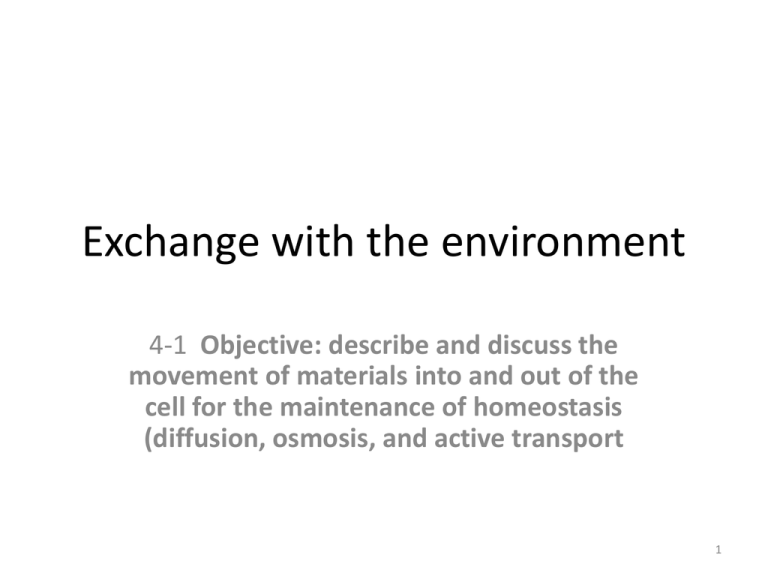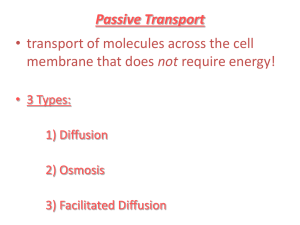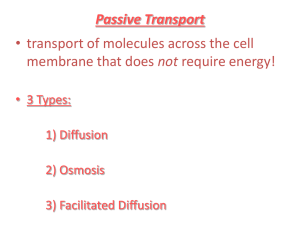Passive and Active Transport
advertisement

Exchange with the environment
4-1 Objective: describe and discuss the
movement of materials into and out of the
cell for the maintenance of homeostasis
(diffusion, osmosis, and active transport
1
Why do cells need to maintain
homeostasis?
• *Cells need to maintain stable
internal conditions (homeostasis),
because of changes in their
surroundings especially with changes
in substances like O2, H2O, CO2, &
NaCl (salt-sodium chloride).
2
What cell part controls what goes in
and out of the cell?
• * The cell membrane controls what
materials pass into or out of the cell
because it is Semipermeable (define)
or selectively permeable =being
permeable to only certain molecules
and not to all molecules.
– it selects which molecules may pass
through
3
Diffusion and Osmosis
• Diffusion (define)
• Materials move from high concentration (lots
of particles) to low concentration (few
particles)
• Can be any very small particle
4
• Osmosis define
– This is diffusion but just of water
– -depends on the concentration of a solute {a
substance dissolved in water}
5
Six molecules
of sugar on the
left to 13 on
the right, but
each side has
the same
number of
water
molecules.
The ratio of
sugar to water
is not equal.
http://porpax.bio.miami.edu/~cmaller
y/150/memb/c8.7x12.osmosis.jpg
The water
moved across
the membrane
so that the ratio
of sugar to
water is in
equilibrium on
both sides.
6
• http://www.biologycorner.com/bio1/diffusion.ht
ml#
• http://highered.mcgrawhill.com/sites/0072495855/student_view0/chapt
er2/animation__how_osmosis_works.html
• This happens in cells because the cell membrane
is semipermeable
7
• * Cells (and entire bodies) must have a way of
getting rid of excess water to maintain
homeostasis even if the water wants to move
into the cell.
• Cells that take in too much water can burst.
8
• Virtual lab demo on disk.
9
Go to Description
10
Hypotonic solution:
very little Solute in
the water
-the concentration
of water inside the
cell is lower than
the concentration
outside the cell, so
water will enter the
cell causing it to
swell or burst.
Isotonic Solution:
Same concentration
-the concentration
of water is the
same both inside
and outside the cell
(compared to the
solute)
-so water moves
into the cell at the
same rate it leaves
the cell.
Hypertonic
Solution:
Lots of Solute in the
water
-the concentration
of water inside the
cell is higher than
the concentration
outside the cell, so
water moves out
causing the cell to
shrink.
Go to pictures
Salt and sugar are common solutes, they are too big to
move through the cell membrane.
11
In Red Blood cells
https://www.msu.edu/~knickerk/webquest/osmosis2.gif
12
Which cell is in a hypertonic solution?
Hypotonic? Isotonic?
13
What does transport mean?
• Two types of transport:
1) passive
2) active
14
Passive Transport
• Define
• NO energy used to move materials
• Only very tiny particles can move across the
membrane by passive transport or diffusion.
• Ex: O2, H2, I2, H20, CO2.
15
Active Transport
• define
• -moves a substance from an area of lower to
higher concentration (opposite of the way
they would naturally move).
• *- this can be into or out of the cell depending
on what the cell needs to maintain
homeostasis.
16
Protein channels (define)
• = passageway through the cell
membrane made up of proteins.
• -Transport proteins (carrier proteins)
= proteins in the cell membrane that pick
up and carry molecules through the cell
membrane
-different types move different types of
particles
17
Other Active Transport
• Endocytosis =define
-may also be called engulfing
• Exocytosis: define
• These are opposite processes
• http://www.maxanim.com/physiology/Endocytos
is%20and%20Exocytosis/ee4.swf
• http://academic.brooklyn.cuny.edu/biology/bio4f
v/page/endocyta.htm
18
New Vesicle
will fuse with a
lysosome
http://www.estrellamountain.edu/faculty/farabee/biobk/endocytosis.gif
19
bp1.blogger.com/.../s400/exocytosis5.jpg
20
http://homepage.psy.utexas.edu/homepage/Cl
ass/Psy308/Salinas/Neurotransmission/release
.gif
21
Movement of Molecules
Process
Requires Energy? Movement
Passive Transport
No
High to low
concentration
Active Transport
Yes
Low to high
concentration
22





